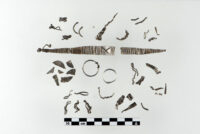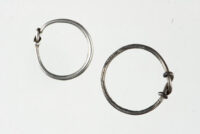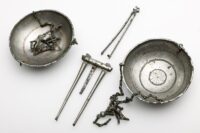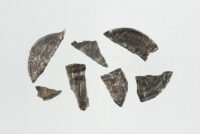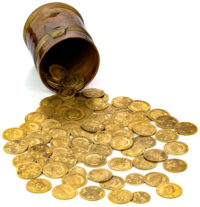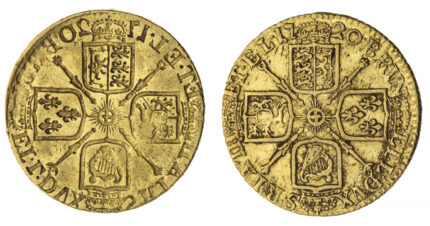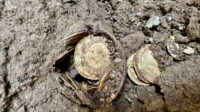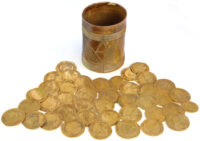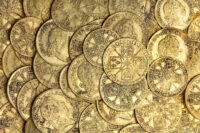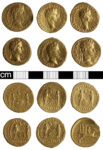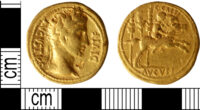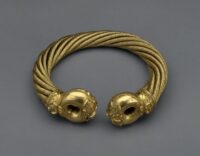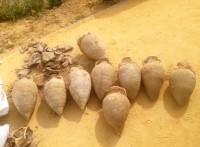 Six years after the discovery of a massive treasure of Roman coins in Tomares, a suburb of Seville, Spain, the first report of the findings has been released by archaeologists and numismatists from the University of Seville.
Six years after the discovery of a massive treasure of Roman coins in Tomares, a suburb of Seville, Spain, the first report of the findings has been released by archaeologists and numismatists from the University of Seville.
The hoard was discovered during city work on the El Zaudín public park. A mechanical digger unearthed 19 large amphorae filled with Roman coins, breaking 10 of them in the process. Workers alerted authorities and archaeologists were promptly dispatched to salvage the coins from the broken amphorae and recover the intact amphorae without damaging them.
All of the amphorae, intact and broken, and the coins were transported to the Provincial Archaeological Museum of Seville for documentation and conservation. From their discovery in 2016 through 2019, experts cleaned, conserved and stored the treasure. The nine intact amphorae were numbered and set 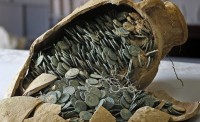 aside and are still unopened as of now, although a microcamera was threaded into them to confirm they are indeed filled with the same quantity and types of coins as the others. Amphorae 10 and 11 were broken but their coin content remained intact within. the microexcavation of the coin groups from 10 and 11 found they contain a similar number coins: around 2,800. The coins from the eight amphorae that were completely fragmented tallied up to 22,288. Another 102 coins were found in a later exploration of the find site. They were scattered, but given the context, they are likely to have been part of the hoard.
aside and are still unopened as of now, although a microcamera was threaded into them to confirm they are indeed filled with the same quantity and types of coins as the others. Amphorae 10 and 11 were broken but their coin content remained intact within. the microexcavation of the coin groups from 10 and 11 found they contain a similar number coins: around 2,800. The coins from the eight amphorae that were completely fragmented tallied up to 22,288. Another 102 coins were found in a later exploration of the find site. They were scattered, but given the context, they are likely to have been part of the hoard.
Archaeologists estimate that the total number of coins in the 19 amphorae is more than 53,000. They are tetrarchic nummi, issued after Diocletian’s financial and monetary reform in 294, but before the reform of 313. A selection of 3,000 coins from the broken amphorae, plus the 2,798 coins in amphora 11 and the 102 scattered coins were cleaned, numbered, photographed, catalogued and underwent metal composition analysis. This sample is more than 10% of the total coinage estimate, giving archaeologists a sufficiently reliable basis for observations that can be extrapolated to the entire hoard.
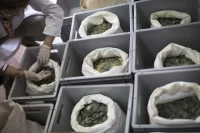 The excavation of the two broken amphorae with largely undisturbed contents revealed that they were both filled in the same manner. The coins were dropped in, forming horizontal layers that stopped before reaching the neck. To ensure there were as few gaps as possible in the layers, the upright amphorae were shaken side-to-side. Coins shifted into the lateral spaces, creating quasi-vertical lines around the edges of the horizontal layers. This strongly suggests that they were filled in a single operation, rather than gradually accumulated. This is confirmed by the absence of any chronological order of coins in the layers. The newest coins were frequently found in the deepest layers, in fact.
The excavation of the two broken amphorae with largely undisturbed contents revealed that they were both filled in the same manner. The coins were dropped in, forming horizontal layers that stopped before reaching the neck. To ensure there were as few gaps as possible in the layers, the upright amphorae were shaken side-to-side. Coins shifted into the lateral spaces, creating quasi-vertical lines around the edges of the horizontal layers. This strongly suggests that they were filled in a single operation, rather than gradually accumulated. This is confirmed by the absence of any chronological order of coins in the layers. The newest coins were frequently found in the deepest layers, in fact.
The coins date to between 294 and 311 A.D. All of the emperors — both Augustuses and Caesars — of the tetrarchic period are represented on the coinage: Diocletian, Maximian, Constantius, Galerius, Constantine, Severus, Maximinus, Licinius and Maxentius. Diocletian’s coins are by far the most common in the hoard. The empire’s main mints are all represented as well: Rome, Carthage, Aquileia, Treveris, Ticinum, Lugdunum, Londinium, Siscia, Ostia, Alexandria, Cyzicus, Thessalonika, Heraklea, Nicomedia, Antioch.
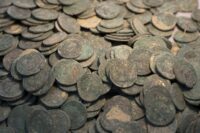 A geomagnetic and stratigraphic survey of the site found the remains of a 3rd-4th century brick building (opus latericium) with buttressed walls typical of warehouses of rural agricultural estates. The structure had a front portico supported by columns that was paved with a lime floor. The 19 amphorae crammed full of coins appear to have been cached under the floor and the lime layer used to seal them in. The building was abandoned in the 4th century and it was dismantled for reuse of its construction materials in the 6th century. Nobody noticed there was a gigantic treasure hidden under the floor.
A geomagnetic and stratigraphic survey of the site found the remains of a 3rd-4th century brick building (opus latericium) with buttressed walls typical of warehouses of rural agricultural estates. The structure had a front portico supported by columns that was paved with a lime floor. The 19 amphorae crammed full of coins appear to have been cached under the floor and the lime layer used to seal them in. The building was abandoned in the 4th century and it was dismantled for reuse of its construction materials in the 6th century. Nobody noticed there was a gigantic treasure hidden under the floor.
The amphorae had been placed with perfect regularity standing upright one next to the other. The vessels are all of the same type and origin: olive oil storage and transport amphorae of local production, the agricultural lifeblood of the area and the likely function of the rural estate where the coins were collected and stashed.
The prevalence of coins from the reign of Diocletian may be an important clue to why they were hoarded in the first place.
The answer could be because as the emperors went by and inflation grew, the weight of the pieces and their percentage of silver fell. In the year 294, a pound of silver was used to mint 32 coins; in 307 this number grew to 40, between 307 and 309 a pound of silver went into making 48 coins, and between 310 and 311, the figure had shot up to 72. In other words, the owner of the treasure preferred to hoard Diocletian’s money, with more silver in it. On average, the coins were made with an alloy of 88% bronze, 4% silver, 3.7% tin and 3.3% lead.
And why so many in the same hands? The researchers explain that Diocletian’s reform triggered “political uncertainty and conflicts between the rulers.” Added to this were territorial and social clashes that would gradually lead to a concentration of property and a devaluation of this type of currency against gold. “These and other factors explain the large amount of coins that were found, as only in large numbers could payments of a certain level be undertaken.” In other words, to make any important financial transaction, a huge number of coins was necessary. And more so if you owned a villa that functioned as an agri-food center.
The Tomares Treasure is one of the largest coin collections from the Tetrarchy (a system of government introduced by Diocletian that involved two emperors and their successors ruling at the same time) in the entire imperial territory. “It is only surpassed in size by that of Misurata, in Libya, and constitutes a top-tier testimony of monetary circulation at the beginning of the 4th century AD in the south of the Iberian Peninsula. Its composition is also an immense archive in which to study the vicissitudes (devaluations, changes in weight) of the economic policy of the emperors of the Tetrarchy, a time when the manipulation of currency was an important economic resource in the hands of public authorities.”
